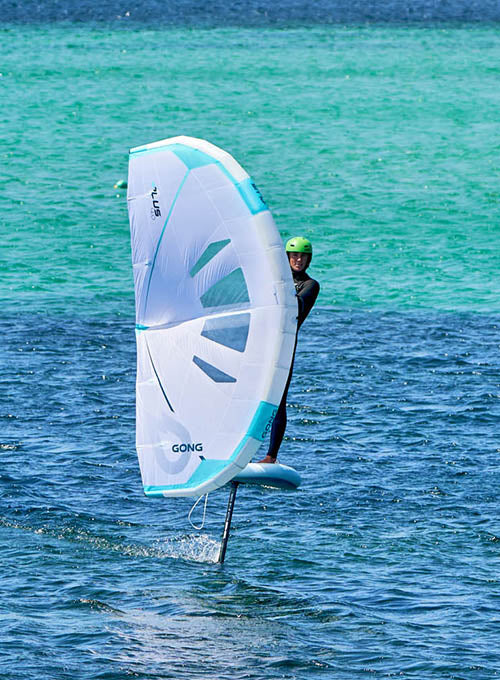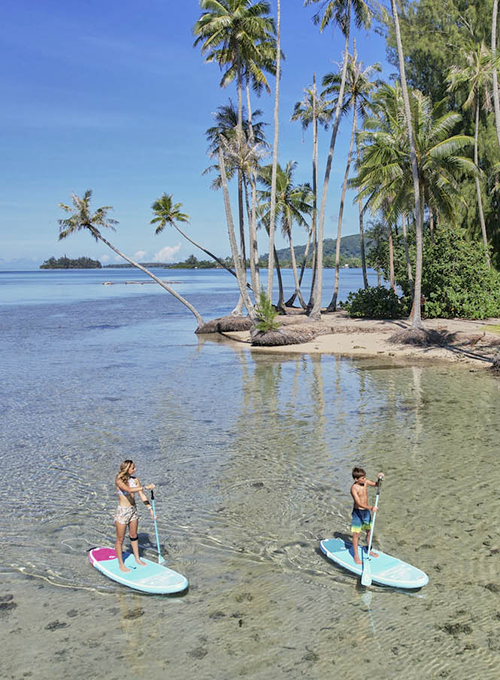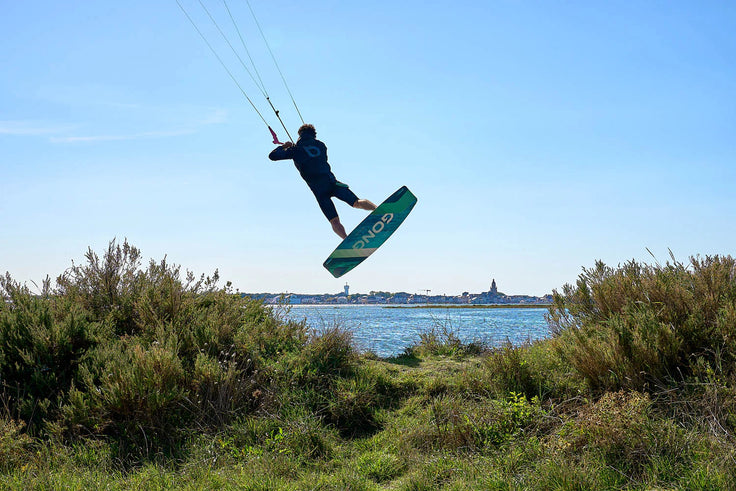Foil Glossary
Get familiar with the vocabulary used by foilers to discuss the technical aspects of their setups.
In the world of foiling, conversations quickly center on equipment and its technical features. Your sensations, performance, and enjoyment on the water all depend on these characteristics. To help you better understand the behavior of each component of your foil, we've compiled detailed descriptions. Below is the essential vocabulary to help you follow any technical explanation with ease.

Wing foiler: Malo,GONG team rider, with a Mint FSP Pro set with a Fluid H foil.
Foil Glossary
- Aspect Ratio: The ratio between wingspan and chord. A high aspect ratio favors glide and speed, while a low ratio improves maneuverability.
- Breach: When the foil exits the water, breaking its lift and causing a loss of control. This often happens with poor management of the height/depth of the foil.
- Camber: The average curve of a wing's profile that determines lift. Higher camber increases lift at low speed, while lower camber improves glide at high speed.
- Canard: A foil setup with the larger and most carrying wings located behind the stabilizer.
- Cavitation: The formation of bubbles around the foil's surfaces at high speed or incorrect angles, leading to a loss of lift. It occurs when pressure around the foil drops so low that water turns to gas.
- Chord: The maximum width of a profile, measured perpendicular to the wingspan. A wide chord generates more lift but also increases drag.
- Critical Angle (Supercritical): A profile designed to delay stall and optimize foil performance at high speeds.
- Dihedral: The angle formed by the inclination of wings relative to the horizontal. Positive dihedral improves lateral stability, while negative dihedral enhances maneuverability.
- Drag: The resistance force opposing the foil’s movement through water, caused by friction and pressure on its surface. Less drag means higher speed and smoother glide.
- Downforce Stabilizer: A rear stabilizer element that counters the pitch-down moment of the front wing, naturally balancing the foil. It stabilizes flight by raising the nose, opposing the front foot's force.
- Elliptical: Describes a wing outline or design with smooth curves, similar to an oval, allowing even lift distribution and better glide.
- Extrados (Upper Surface): The outer surface of the wing, often curved, where water moves faster, creating lower pressure and contributing to lift.
- Fillet: A smoothed junction between two surfaces, often a convex quarter-circle. Fillets enhance strength and reduce drag for improved glide.
- Flex: The ability of the wing or mast to deform under pressure. A rigid foil offers more responsiveness, while flexible foils absorb pressure for comfort but reduce precision and control.
- Front Wing: The foil’s front wing generates most of the lift needed for flight.
- Fuselage: The bar connecting the front wing to the stabilizer, providing structure to the foil. A long fuselage enhances stability, while a short one increases reactivity.
- Glide: The foil’s ability to maintain speed while sliding effortlessly. Good glide covers long distances with minimal energy.
- Incidence: The angle of the foil's attack relative to water flow. A positive angle increases lift, but excessive angles cause vibrations, ventilation, and stall.
- Intrados (Lower Surface): The inner surface of the wing, usually flatter than the extrados, where water moves slower and pressure is higher, contributing to lift balance.
- Leading Edge: The front edge of a wing or stabilizer that first contacts the water flow. A streamlined leading edge reduces drag and improves glide.
- Lift: The upward force that raises the foil and board above the water. Lift depends on wing profile, speed, and angle of attack.
- Lower: The complete underwater structure of the foil, including the fuselage, front wing, and stabilizer. This structure acts like the wings of an airplane, generating lift.
- Mast: The vertical component connecting the fuselage and wings to the board. Mast height affects the foil’s ability to glide above water without ventilation.
- Pitch-down Moment: The forces applied to the front wing that tend to make it dive despite its lift, necessitating the stabilizer.
- Profile: The cross-sectional shape of the wing, affecting lift and drag. Thick profiles generate more lift, while thin profiles reduce drag for higher speeds.
- Pumping: A flexion-extension leg movement to maintain or increase foil speed without wind or waves. Used to activate the foil while surfing or in light wind.
- Rake: The mast's tilt angle relative to vertical. Increased rake can enhance glide and balance, affecting the front foot’s workload in some configurations.
- Stabilizer (Stab): The foil's rear wing, providing stability and controlling pitch. It offsets the front wing’s lift to regulate flight angle.
- Stall: A loss of lift caused by an angle of attack that is too high or mismatched to the optimal speed, leading to instability.
- Tip: The end of a wing, influencing maneuverability and drag. Raised tips help manage partial stalls.
- Top Plate: The mast base attached to the board, ensuring a strong and rigid connection. Adjustable plates allow for incidence angle tuning to modify foil lift.
- Trailing Edge: The rear edge of a wing where water detaches after passing the profile. A fine trailing edge reduces drag and enhances glide stability.
- Twist: The wing’s torsion along its span, adjusted to balance lift. Progressive twists adapt lift from base to tips. Mast twist reduces flight precision and may cause ventilation.
- Ventilation: Air entering around the wings or mast near the water's surface, reducing lift and potentially causing stall.
- Wingspan: The total length of the wing from tip to tip. A large wingspan improves glide but reduces maneuverability.





